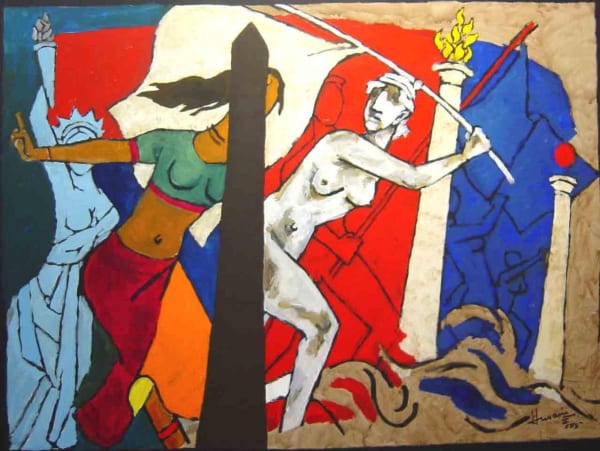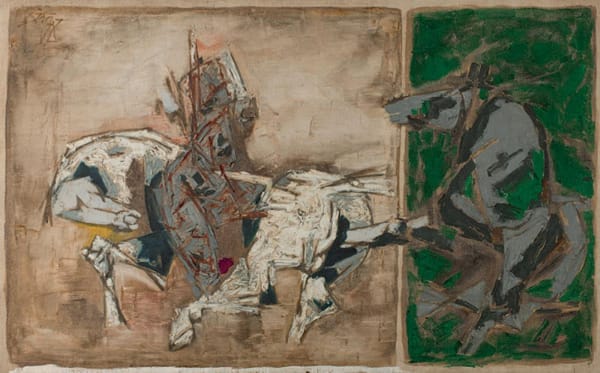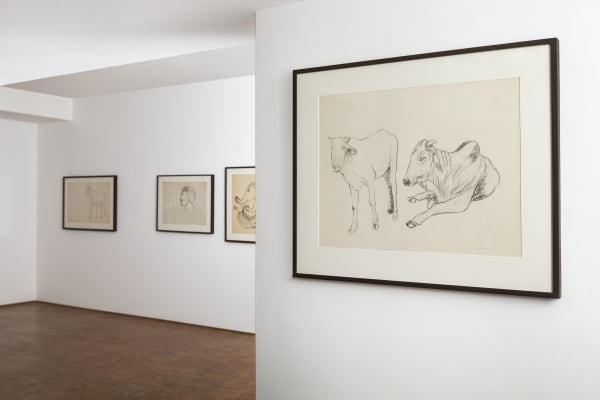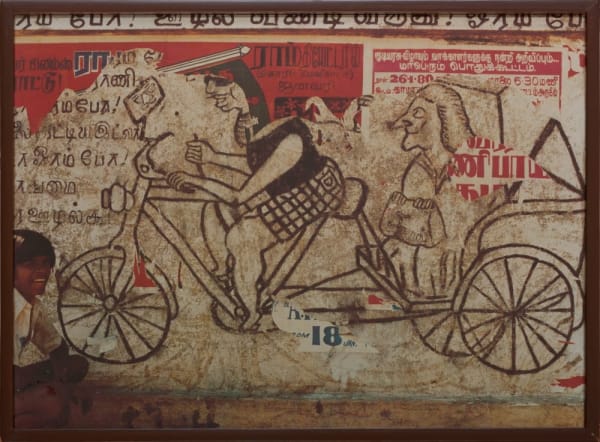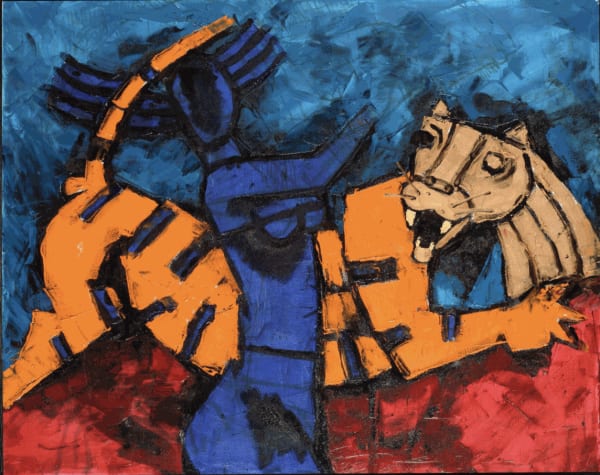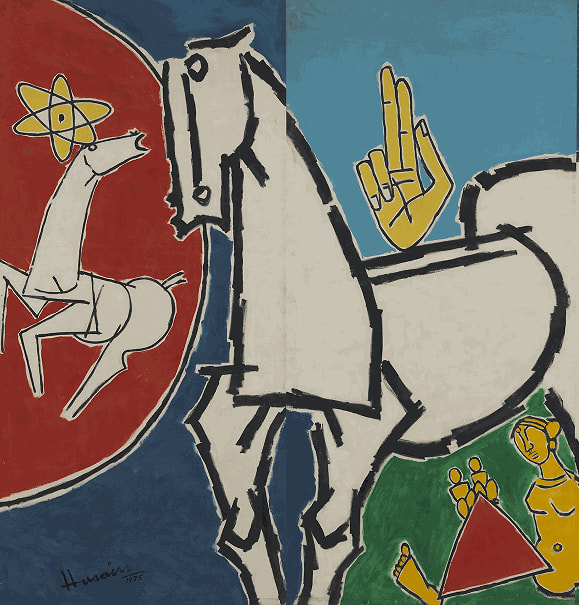M.F. Husain Indian, b. 1915
Born in 1915 in Pandharpur, Maharashtra, Maqbool Fida Husain was brought up by his grandfather after the early death of his mother. In 1919 he moved to Indore to be with his father, where in the following years he started drawing and painting on his own, enrolled in a religious education, developed a fascination for cinema and languages, wrote Urdu poetry and developed an interest in calligraphy. Leaving the diploma course at the Indore School of Art, Husain was admitted into the Sir J.J. School of Art, where he was also unable to complete his studies due to the death of his father. He subsequently moved to Bombay, got married, and got a job at a furniture shop designing nursery furniture and wooden toys.
In 1948, Husain left his job to join the Progressive Artists’ Group founded by his contemporary F.N. Souza, after which he fully embraced his yet-to-be prolific career as an artist. In 1950, Husain held his first solo show in Bombay, and travelled extensively around South Asia and Europe fraternizing with renowned artists such as Chi Pei She, Emile Nolde, Paul Cézanne, Paul Klee and Pablo Picasso. In 1954, he painted his landmark ‘Passage of Time’ piece, marking the beginning of his world renowned horse paintings. He went on to hold solo shows in Zurich, Prague, Tokyo, Baghdad, Kabul, Rome, New York, Bombay and New Delhi, and executed a number of life-size murals for Air India and the Lalit Kala Academy, New Delhi. In 1963, he painted his first portrait, which was of Jawaharlal Nehru.
In 1959, Husain won an award at the Tokyo biennale, in 1966 was awarded the Padma Shri by the Government of India, and in 1973 received the Padma Bhushan as well. In 1968, he won a National Award for his direction of the short film Through the Eyes of a Painter, previously receiving the Golden Bear Award at the Berlin Film Festival. In 1986, he became a member of the Rajya Sabha of Parliament, and in 1989 was awarded the Padma Vibhushan by the Government of India.
One of the most famous artists in the world, he is largely credited with modernizing the Indian art movement and remains an influential figure in the contemporary art world today. Husain’s master oeuvre of painting is marked by several specific periods in terms of style as well as subject matter, after his horse series – Mother Teresa, the Mahabharata, Calligraphy and Sufis, Indira Gandhi, Al Arabia and the Raj. His skillful and entrepreneurial expedition into the arts was not limited to the visual arts; Husain also attempted jewellery design, writing and several other feature-length films.
The artist died in 2011, in London, following a heart attack, at the age of ninety-five.
-

Delhi Contemporary Art Week 2024
Bikaner House, New Delhi 31 August - 4 September 2024Gathered for a democratic and diverse audience, our curation includes works across mediums,with a focus on painting and photography,ushering in reflection and discourse on topical narratives growing out of contemporary...Read more -

People, Places, Things
D-40 & D-53 Defence Colony, New Delhi 6 May - 15 June 2024Belonging to someone, somewhere or something is an experiential arrangement. These social relations form the crux of the human behavioral sciences, which seek to study why human beings engage in...Read more -

Time of the Line
D-40 Defence Colony, New Delhi 2 May - 10 July 2023A line is a thing of many. It can carry a poem from a spark to its end, or be telling of age when gathered around cheekbones, or ponder a...Read more -

M.F. Husain | Lines of Thought
D-40 Defence Colony, New Delhi 5 September - 5 October 2019Lines of Thought is an exhibition of M.F. Husain’s drawings, featuring 22 executions of line that he produced, as is widely speculated, around the time he left India for England....Read more -

OFF THE RECORD: Meditations on the Photographic Image | Curated by Vidya Shivadas
D-53 Defence Colony, New Delhi 28 October - 2 December 2015This exhibition brings together a group of nine artists who have diverse engagements with the medium of photography within their practice. The presence of photography, both latent and manifest, has...Read more -

M.F. Husain: '88 Oils
D-40 Defence Colony, New Delhi 1 January - 1 February 2003Read more
-

Asia Society Museum in New York presents M.F. Husain: Art and the Nation
Asia Society 24 December 2021Asia Society Museum presents Lightning , a mural-sized painting by M.F. Husain, a founding member of the Bombay Progressive Artists Group. Created during a tumultuous...Read more -

New exhibition showcases collection of Husain's line drawings
The Week 4 April 2020Over 20 line drawings by modernist painter Maqbool Fida Husain, believed to be created around the time he left India for England, are on display...Read more -

New exhibition showcases collection of MF Husain’s line drawings
Hindustan Times 10 September 2019Over 20 line drawings by modernist painter Maqbool Fida Husain, believed to be created around the time he left India for England, are on display...Read more -

An exhibition in Qatar celebrates how artist MF Husain embraced the world
By Vandana Kalra | The Indian Express 22 April 2019In 2010, when MF Husain was conferred Qatar nationality, the artist acknowledged it through a sketch that featured his trademark horse alongside words that expressed...Read more -

M.F. Husain: the master’s last works
By Radhika Iyengar | Mint 6 April 2019In February 2010, M.F. Husain took a blank sheet of paper and drew the silhouette of a horse—a regular presence in the artist’s works. Right...Read more -

The Arab Museum of Modern Art celebrates MF Husain with retrospective
By Ranjit Hoskote | Mumbai Mirror 24 March 2019 Read more -

An Exile’s Eye on India
By Vandana Kalra | The Indian Express 11 July 2017At 95, when he died in exile in London, MF Husain was still painting several hours a day. He dreamed of returning to India, his...Read more -

M. F. Husain’s Modern India at the Art Institute of Chicago
By Daniel McDermon | New York Times 5 July 2017The artist M. F. Husain honed his skills in 1930s Mumbai as a painter for hire, creating vivid billboards to draw audiences for the growing...Read more -

Google Vividly Honours MF Husain on His 100th Birthday
NDTV 17 September 2015Today's Google Doodle celebrates the 100th birthday of one of India's most renowned and multifaceted artists, Maqbool Fida Husain, who passed away on June 9th,...Read more -

A Finale for 'the Picasso of India'
By Shanoor Seervai | Wall Street Journal 30 May 2014The public is getting its first chance to see some of the last works of Maqbool Fida Husain, sometimes called 'the Picasso of India.' Husain...Read more -

MF Husain's 'Last' Works
By Kishore Singh | Forbes India 13 May 2014At 93 years of age, MF Husain could have been forgiven for calling it a day. But when he sought exile from India in 2006—on...Read more

